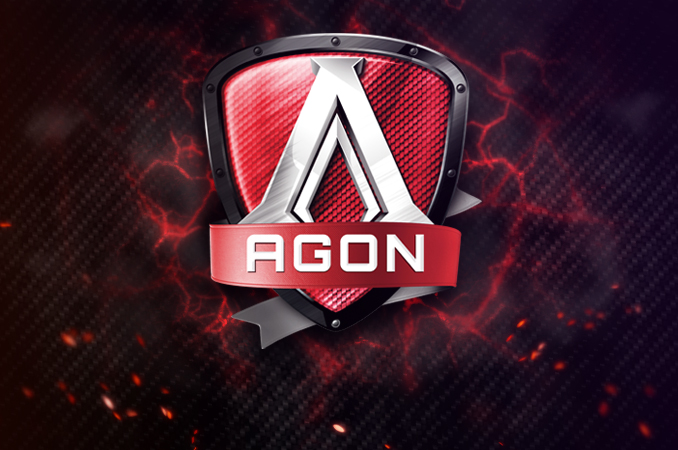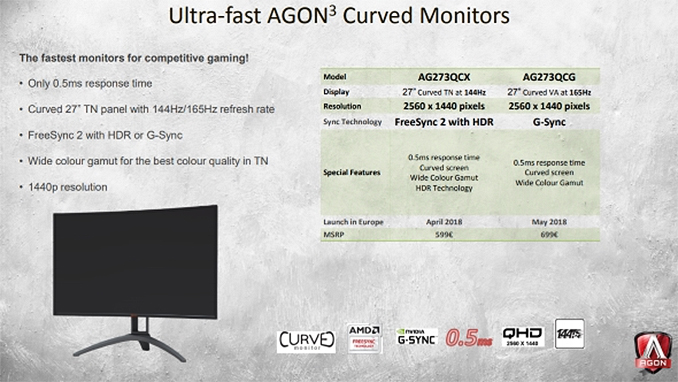AOC to Launch Curved QHD Displays with 0.5 ms Response Time in 2018
by Anton Shilov on August 26, 2017 9:00 AM EST
In a surprising move, AOC has announced plans to launch a new series of AGON gaming displays with a 0.5 ms response time in Q2 of next year. The displays will be curved, will feature a QHD resolution and will rely on a new TN panel from AU Optronics. The monitors will support adaptive refresh rate technologies from AMD and NVIDIA and will certainly not be cheap.
The big question with this announcement is of course how exactly did AUO and AOC manage to decrease the GtG response time of a TN panel to 0.5 ms? So far, AUO has not publicly announced this panel. Moreover, given the striking similarity of the panel used for the AG273QCX/AG273QCG and Acer's Predator Z271UV (same size, curvature, brightness, ‘wide gamut’, up to 165 Hz refresh rate, etc.), it is possible that the panels are close relatives, but the one used by AOC features a technique that cuts GtG response time from 1 ms to 0.5 ms. Either way, details are unfortunately slim at this time, but given AOC's bold claim, this bears further watching.
Otherwise, AOC’s AGON AG273QCX and AGON AG273QCG have a lot in common: both are based on the same 27” curved display panel from AUO featuring a 2560×1440 resolution, a wide color gamut (more on that below), very high refresh rates of 144 and 165 Hz, 400 nits brightness, as well as the aforementioned 0.5 ms response time. The key differences between the AG273QCX and the AG273QCG are different adaptive refresh rate technologies: the former supports AMD’s FreeSync 2 with HDR, the latter features a bit higher refresh rate and NVIDIA’s G-Sync (sans HDR). The lack of HDR on the G-Sync model presumably being due to the fact that NVIDIA mandates at least 1000 nits for its G-Sync HDR platform.
| AOC's AGON³ Displays with 0.5 ms Response Time | ||||
| AG273QCX | AG273QCG | |||
| Size | 27" | |||
| Panel Type | Curved TN | |||
| Resolution | 2560×1440 | |||
| Pixel Response Time | 0.5 ms | |||
| Color Gamut | 'Wide Color Gamut' | |||
| Maximum Refresh Rate | 144 Hz | 165 Hz | ||
| Adaptive Refresh Rate Tech | AMD FreeSync 2 | NVIDIA G-Sync | ||
| Launch Time in EU | April 2018 | May 2018 | ||
| MSRP | €599 ($706) | €699 ($824) | ||
Unfortunately, AOC does not specify what exactly the “Wide Color Gamut” support mentioned in its slides means. But given that we have seen a degree of DCI-P3 support on the TN-based Acer Predator Z271UV, this is a distinct possibility for the new AOC displays as well. Along those lines, one of AOC’s representatives said in a conversation with PCGamesN website that the new TN panel from AUO is not only fast and relatively bright, but also has a considerably improved color quality, which the rep compared to IPS-based displays. The official for AOC confirmed that the panel still has TN’s traditional 170°/170° viewing angles, but argued that gamers would not feel it due to their usage model.
AOC promises that the AGON AG273QCX featuring the FreeSync 2 with HDR will hit the market in April 2018 and will cost €599 ($706). The G-Sync-supporting AGON AG273QCG is expected to be available in May 2018 for the price of €699 ($824). Keep in mind that since displays are based on brand new panels, their MSRPs and ETAs at the moment are preliminary and they may change.
The actual slide demonstrated by AOC at Gamescon has a typo: both displays are based on a TN panel.
Related Reading:
- AOC Launches the AG352QCX: 35-Inch 200 Hz 2560×1080 Curved Display with Adaptive-Sync
- AOC Expands AGON Family with Curved AG322QCX and AG272FCX 144 Hz Displays
- ASUS ROG Strix XG27VQ Available: 27” Curved, FHD@144Hz & FreeSync w/ELMB
- BenQ Announces ZOWIE XL2546 ‘eSports’ Display: 24'', FHD, 240 Hz, DyAc ULMB Tech
- Samsung Announces First Freesync 2 Monitors: CHG70 & CHG90 - Quantum Dots, Up to 49”, 144 Hz, DCI-P3
- Acer Predator Z35P Available for Order: Curved 35" with 3440×1440@120 Hz and G-Sync
Sources: PCGamesN (via TechPowerUp).











29 Comments
View All Comments
cfenton - Saturday, August 26, 2017 - link
Will that reduction in response time make any real-world difference? We're talking about going from 1/1000th of a second to 1/2000th of a second. Sure, it's faster, but would anyone be able to tell in a blind test?TallestJon96 - Saturday, August 26, 2017 - link
Its not about reaction times as it is clearity. If the image changes 165 times a second, and each one takes 1ms, you spend 16.5% of the time with a blurry screen. Now thats assuming constant rapid movement, and the extent of the blur can vary, but this can supposedly cut it in half.squngy - Saturday, August 26, 2017 - link
Yes, but 0.5s is only for GtG, which is traditionally the best case scenario for TN.If they actually managed to cut all response time in half this will be very significant, but somehow I doubt it.
saratoga4 - Saturday, August 26, 2017 - link
>and each one takes 1ms, you spend 16.5% of the time with a blurry screen.If each transition takes 1ms, you spend exactly 0% of your time perceiving a blurry screen though, since you can't perceive spatial frequencies on such a short time scale.
mdrejhon - Sunday, August 27, 2017 - link
GtG is not the main cause of motion blur. See www.testufo.com/persistenceAlso, you should see the 480Hz monitor review to see how effects are perceived:
https://www.blurbusters.com/4k-120hz-with-bonus-24...
mdrejhon - Sunday, August 27, 2017 - link
Chief Blur buster here.GtG is very important for good strobe backlights (motion blur reduction modes) or ultra-high-Hz. The faster the GtG, the better quality the strobing is, less strobe crosstalk, as more GtG gets crammed into the VBI between refresh cycles.
0.5ms vs 1ms makes no diff for 60Hz non-strobed though.
Lolimaster - Saturday, August 26, 2017 - link
My Trinitron CRT Monitor 0.0001ms.mdrejhon - Monday, February 19, 2018 - link
Yes, it is still noticeable, especially with reduced strobe crosstalk for strobed modes. The faster the LCD GtG response, the easier it is to complete pixel transitions in the VBI (finishing LCD GtG in blanking interval between refresh cycles). This produces better motion blur reduction modes.Also, it's worth reading www.blurbusters.com/1000hz-journey about why the continued refresh rate race is worth it.
TL;DR: The progress to 1000 Hz + will eventually produce the equivalent of strobeless ULMB (blurless sample-and-hold) which is closer to real life, since real life has no display-added extra motion blur, nor display strobing.
SetiroN - Saturday, August 26, 2017 - link
Just bring on the goddamn OLED panels already.Alistair - Saturday, August 26, 2017 - link
I hear that!